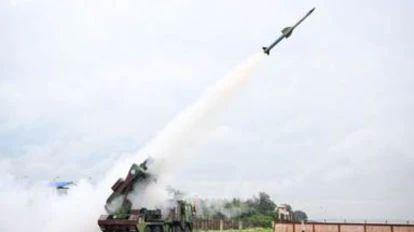Bhubaneswar। August 25, 2025। SKY LINK TIMES
In a significant stride towards India’s defence self-reliance, the Defence Research and Development Organisation (DRDO) successfully conducted the maiden flight tests of the Integrated Air Defence Weapon System (IADWS) off the Odisha coast around 12.30 pm on Sunday.
The test is being seen as a crucial step under Mission Sudarshan Chakra 2035, India’s ambitious roadmap to build a comprehensive, homegrown, multi-domain security shield against evolving global threats.

A Boost to ‘Atmanirbhar Bharat’ in Defence
The successful test comes just days after Prime Minister Narendra Modi, in his Independence Day address, urged the nation’s defence ecosystem to accelerate the development of indigenous technologies. Answering the call, DRDO’s achievement reinforces India’s commitment to strengthening ‘Atmanirbhar Bharat’ in the field of advanced defence systems.
What the IADWS Means for India
The Integrated Air Defence Weapon System is designed to detect, track, and neutralize a wide spectrum of aerial threats, including hostile aircraft, drones, and precision-guided missiles. Its indigenous development means India is reducing dependence on foreign suppliers while enhancing its own capacity to respond swiftly to security challenges.
Officials confirmed that the test validated several key parameters, including system accuracy, target interception, and real-time command-and-control integration. “This is only the beginning of a new era in India’s defence preparedness. With IADWS, India moves a step closer to creating a nationwide protective shield,” a senior DRDO scientist noted.
Mission Sudarshan Chakra: India’s 2035 Defence Vision
Launched as a long-term national security initiative, Mission Sudarshan Chakra aims to establish an indigenously developed multi-layered defence architecture by 2035. It envisions a comprehensive shield capable of countering threats from land, air, sea, space, and cyber domains.
The IADWS test is being hailed as the first decisive move in this mission. By 2035, India plans to field a fully integrated system linking sensors, radars, interceptor missiles, and artificial intelligence-driven command networks across the nation.
Also Read: https://skylinktimes.in/india-to-build-its-own-space-station-says-pm-modi-on-national-space-day/
Growing Global Relevance
Experts believe that India’s advancements in indigenous defence technology not only strengthen national security but also enhance its standing in the global defence market. With increasing focus on cutting-edge innovation, India could soon emerge as a reliable exporter of advanced defence systems.
Looking Ahead
Defence analysts see the maiden flight test as a historic moment for the country’s armed forces and its research community. While more rounds of testing, fine-tuning, and integration remain, the successful demonstration has instilled confidence that India is firmly on the path to achieving its 2035 security goals.
The Ministry of Defence is expected to release further details on upcoming trials and deployment timelines in the coming weeks
With this milestone, India has sent a clear signal of its determination: to build a self-reliant, robust, and multi-domain defence shield that can stand strong against any emerging threat.
For More Info Stay Tuned: https://skylinktimes.in



